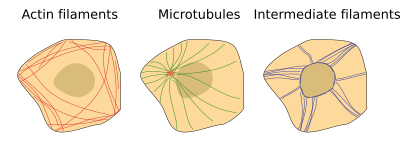The nucleus and cellular organelles are not randomly scattered in the cytoplasm. Indeed, there is a functional and structural internal organization ruled by several types of proteins arranged in filaments, jointly known as the cytoskeleton. These filaments form a dynamic scaffolding distributed through the cytosol, although some of them are found inside the nucleus.
The word "cytoskeleton" is a morphological and structural term coming from the early observations of cells at electron microscopy. It may lead to a misunderstanding because the cytoskeleton is not a static scaffold for supporting cell structures. Actually, it is a very dynamic structure responsible for cell movement and shape, and for organelle arrangement and movements. The functional diversity of the cytoskeleton is a consequence of its molecular features.
Polymerization and depolymerization. Cytoskeleton filaments are formed by polymerization of repeated protein units that do not establish chemical bonds between each other, but they are linked through electrical forces. In this way, filaments can be assembled (polymerized) and disassembled (depolymerized) easily and according to the cell needs. Cells may form and modify filament scaffolds where they are needed. Proteins that form cytoskeleton filaments are constantly changing between polymerized and free in the cytosol.
Polarization. Some cytoskeletal filaments are polarized structures; that is, all the protein units in the filament are in the same orientation. Thus, the two ends of the filament are different. This arrangement is important for filament growth and for those proteins that have to know where a type of filement is and thus movin along the filament in a spercific direction.
Regulation. Cells have many proteins to control the organization and activity of cytoskeleton filaments. They are tools for manipulating the three-dimensional scaffold of cytoskeleton filaments. For instance, motor proteins are molecules that use cytoskeletal filaments as train rails to transport cargoes (vesicles, organelles, macromolecules) through the cytoplasm. Other proteins are involved in filament polymerization-depolymerization, spatial organization, filament stability, or are intermediaries between filaments and other cell structures.
Cytoskeleton performs an amazing amount of functions in eukaryotic cells. It makes cells to move, establishes the cell shape, makes possible the polarity of some cells, distributes intracellular organelles properly, is responsible for the communication between those organelles and exocytosis and endocytosis processes, runs cell division (both mitosis and meiosis), is a good scaffold for maintaining intracellular organization, resists mechanical forces, withstands cell deformations, and many others. Although some homologous cytoskeletal proteins have been found in prokaryotes, the cytoskeleton appears to have been invented by eukaryotic cells. The mechanical function of the cytoskeleton is particularly useful in animal cells, where no cell wall gives consistency to the cell. Without a cytoskeleton, animal cells will break because the plasma membrane is just a sheet of fat.
Cytoskeleton is composed of three types of filaments: actin filaments (or microfilaments), microtubules, and intermediate filaments (Figure 1). Actin filaments, polymers of repeated units of the actin protein, are in charge of cell movements, endocytosis, phagocytosis, cytokinesis, and other functions. They are also part of the molecular machinery needed for muscle contraction and of some cell junctions (adherent junctions and tight junctions). They are named microfilaments because their diameter is lower than that of the other cytoskeleton components. Microtubules, as the name suggests, are tubules made up of dimers of α- and β-tubulin. Microtubules are needed for the intracellular movement of organelles and vesicles, constitute the skeleton of cilia and flagella, drive chromosome segregation during cell division, etcetera. Actin filaments and microtubules are helped by motor proteins, which are actual motors that can move along the filaments. Actin filaments and microtubules are used as rails by motor proteins to carry cargoes. Cargoes may be chromosomes, organelles, or macromolecular complexes. Intermediate filaments are responsible for cell integrity since they function as strong intracellular cables anchored to cell junctions like desmosomes and hemidesmosomes. They make possible the adhesion of contiguous cells and between the cell and the extracellular matrix, contributing to the cohesion of tissues. They are specialized in withstanding mechanical forces. Unlike the other components of the cytoskeleton, intermediate filaments are polymers that can be made up of different families of proteins, such as keratins, vimentins, laminas, and some others.

 Cytosol
Cytosol